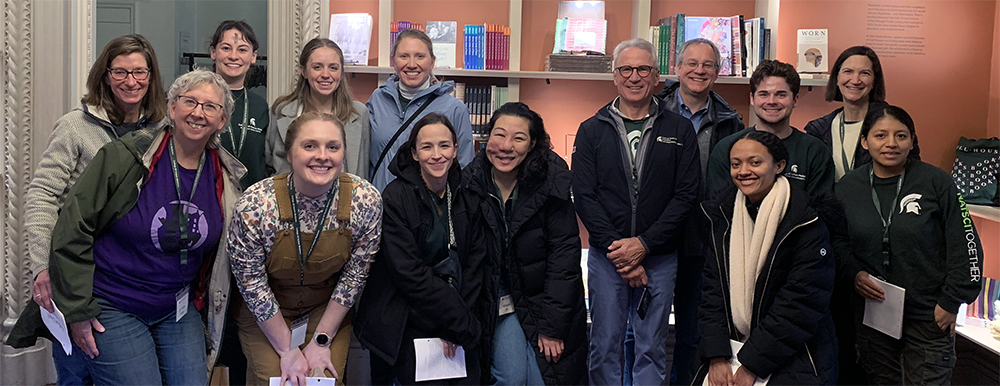Dean's Update
March 7, 2025 - Aron Sousa, MD

The students and faculty of the 2025 College of Human Medicine Chicago Emersion Alternative Spring Break Trip.
Friends,
This week, an intrepid group of our students and faculty did an alternative spring break in Humbolt Park, Chicago. And they let me hang out with them a little bit, while I otherwise met with local alumni and continued my usual work. My thanks to Lauren Sellers (MS2) and Haley Divis (MS2) for their excellent work organizing and leading the trip. Our folks have been based with the sisters of Our Lady of Angels, where they have worked with community members and helped staff a big, vibrant food pantry. Over a two-hour stretch, I got to hand out meat and vanilla extract to 450 people who came into the mission for the food pantry. The sisters are so dedicated to improving the lives of the people in their neighborhood. They are amazing.
I did not get to do many of the other community activities with the students like the afterschool events and the elder’s breakfast, but I did accompany them on a tour of Hull House, the Near West Side settlement house founded in 1889 by Jane Addams and Ellen Gates Starr. For the uninitiated, Jane Addams was one of the most influential people of her time. She is considered the founder of social work as a field, and her fellow residents of Hull House were the starting point for much of what we take for granted today: public playgrounds, afterschool programs, community arts education, and community-based science. Because women were often not afforded the opportunity to be faculty at colleges and universities, Hull House became the academic institution and scholarly center for a remarkable group of women.
Settlement houses were a phenomenon of the late nineteenth century that brought academics into poor communities to do their scholarship in and with the people in those poor neighborhoods. The residents/researchers of Hull House surveyed community members and published a fascinating and groundbreaking group of maps and essays about the surrounding neighborhood. The publication, called the Hull House Maps and Papers, plotted the wage, ethnicity, and occupation distribution across the community, and then used that data for remarkable papers like “Wage Earning Children” and “Art and Labor.” Addams and company overtly linked their residency in the community, their research, and their reform work to improve policy and the lives of people around them.
As a part of this trip, I asked that we visit Hull House. I had not even heard about the settlement movement until I started reading the work of the American pragmatist, John Dewey, who developed some of his educational philosophy from the afterschool and adult education programs at Hull House. Once I started reading about Hull House and the Settlement House movement, I realized that our community-based medical school could function in our communities as Hull House functioned in the 19th Ward of Chicago.
In my proposal presentation to the Charles Stewart Mott Foundation Board of Directors, I promised we, as a college, would be resident in the community of Flint and invite the community to be our collaborators in the research and advocacy of the faculty. Since 2015, the college has brought more than $200M in external funding to Flint, more than 150 university jobs, and another 30 jobs with our collaborating partners. Our faculty have used maps to show the age of the water in the Flint system was directly linked to the lead in kids during the water crisis. And the interventions created and investigated by our faculty and Flint resident collaborators have changed food policy, suicide prevention, and how we improve maternal mortality.
This week, Rx Kids, a Flint-born program dedicated to reducing child poverty in the first year of life, expanded to cover the five eastern counties of the Upper Peninsula. In the blue city of Flint and the red counties of the Eastern UP, the Rx Kids team is working to reduce child poverty one mom and one kid at a time, regardless of who they are, how much they make, what they look like, or who they love. Just like the women of Hull House, the Rx Kids team embraces their community and uses research to guide reform and improve the lives of those around them.
So much is in flux right now, but there is solace in the simplicity of embracing community and working to make people’s lives better like the sisters in Humbolt Park, on the Near West Side, in Flint, in the Upper Peninsula, and each community the people of the college serve every day.
Serving the people with you,
Aron
Aron Sousa, MD, FACP
Dean, Michigan State University College of Human Medicine

